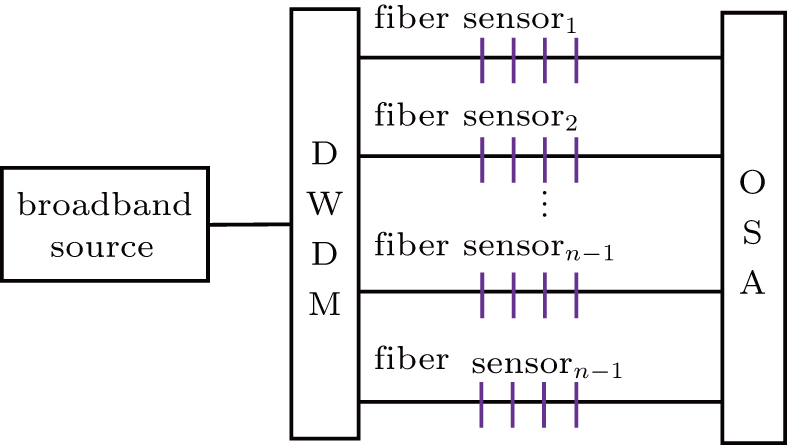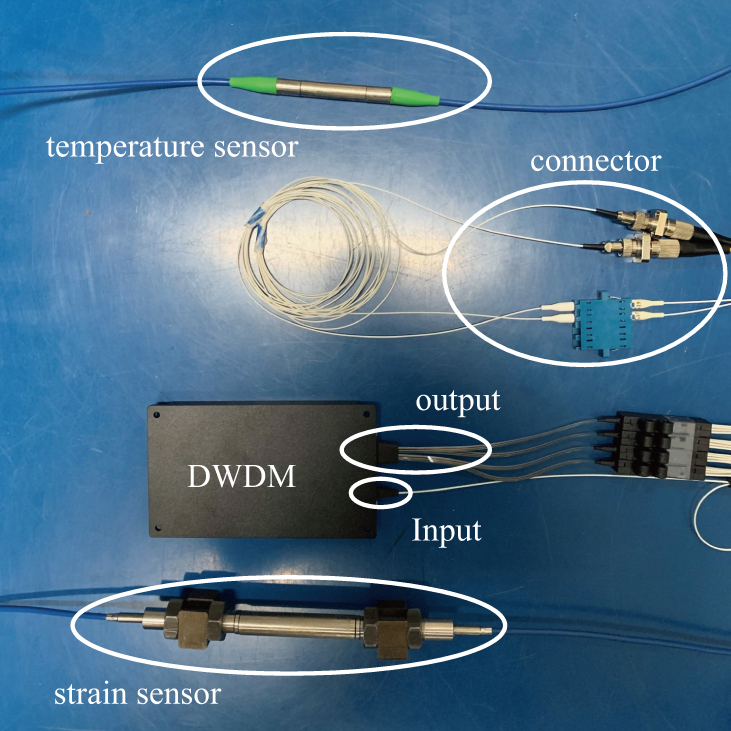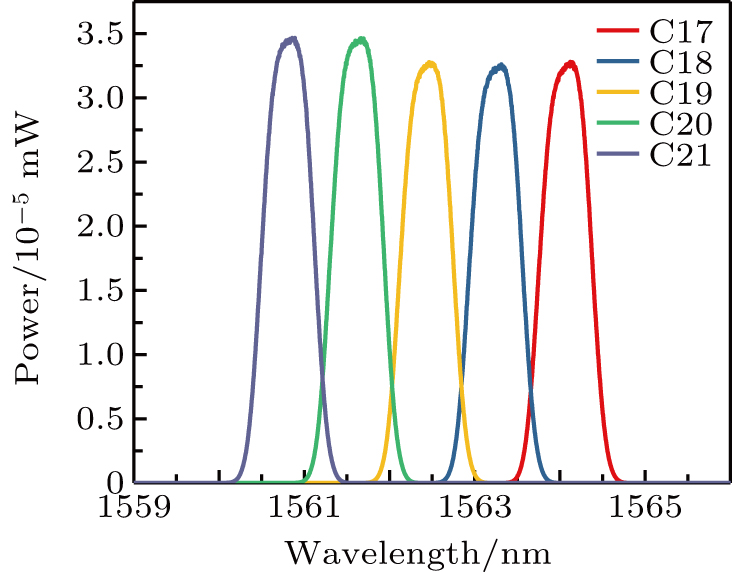† Corresponding author. E-mail:
Project supported by the National Key Research and Development Program of China (Grant No. 2016YFB0402504), the National Natural Science Foundation of China (Grant Nos. 61875069 and 61575076), Hong Kong Scholars Program, China (Grant No. XJ2016026), and the Science and Technology Development Plan of Jilin Province, China (Grant Nos. 20190302010GX and 20160520091JH).
We propose a novel and efficient multi-functional optical fiber sensor system based on a dense wavelength division multiplexer (DWDM). This system consists of an optical fiber temperature sensor, an optical fiber strain sensor, and a 48-channel DWDM. This system can monitor temperature and strain changes at the same time. The ranges of these two sensors are from −20 °C to 100 °C and from −1000 

Owing to the advantages of their low cost, high sensitivity, electromagnetic immunity, and easy fabrication, optical fiber grating sensors have been widely invested in and used in many fields, including medicine,[1] robotics,[2] and industrial monitoring, where there is assessment of parameters such as force,[3] temperature,[4] liquid level,[5] and vibration[6] in both point and quasi-distributed measurements.[7] However, most of these optical fiber sensors hardly realize functional integration if these parameters might ever be similar.[8,9] In the meantime, optical networks have been invested in because of the rapid increase of data traffic in communication in the last two decades. Dense wavelength division multiplexers (DWDMs)[10–12] as well as coarse wavelength division multiplexers (CWDMs)[13–15] have been widely researched around the world, making multi-channel sensors possible. In order to make the best use of instruments and sensors, the multi-channel sensor system[16] and control system[17] have been proposed recently. Nevertheless, these systems are still limited in the same parameter. Optical multi-functional integration is becoming a compelling path towards delivering optical modules with enhanced functionality at a reduced cost.[18]
In this paper, we demonstrate a multi-functional optical fiber system based on a DWDM. The system consists of an optical fiber temperature sensor, an optical fiber strain sensor, and a 48-channel DWDM. A broadband source is divided into 48 parts with a wavelength spacing of 0.8 nm. Two different kinds of optical fiber sensors are connected with 2 channels of this DWDM. A spectrometer is used to detect the spectrum from the output ports of these two sensors. We find spectral shifts according to the temperature change and the strain change. Then we can obtain the temperature and strain in this situation. The sensor system demonstrated can monitor two parameters simultaneously and realize the functional integration, which can be used to monitor remote environmental changes through an optical fiber network. Since a multi-functional monolithic device is compact and urgently needed,[19] further work will include integrating different functions on one chip.
Figure

On the other hand, the strain sensor will also be affected by temperature disturbance. In our experiment, we try our best to keep the room temperature constant so that we can ignore the effects of temperature change and then monitor the strain change applied to the sensor. The interference wavelength will be changed with the strain variation, and the relationship can be described as[20]

In order to verify our design, we built the multi-functional optical fiber sensor system and measured the relative parameters. Figure
Next, we characterized the function of the optical fiber strain sensor. Because the strain or the stress change can be characterized by forces, we applied different forces to the sensor and obtained a series of spectra, as shown in Fig.
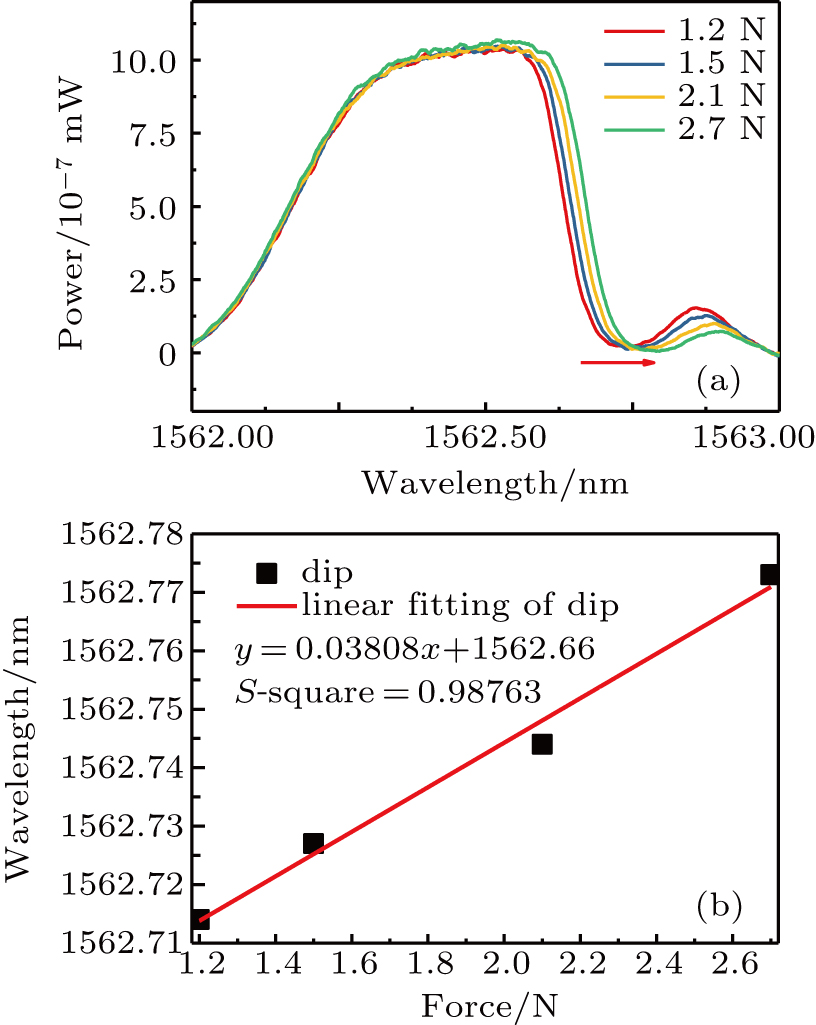 | Fig. 4. (a) The measured spectrum of the strain sensor. (b) The relationship between the force and the interference dips. |
Then, we characterized the function of the optical fiber temperature sensor. We applied different temperatures to the sensor and obtained a series of spectra, as shown in Fig.
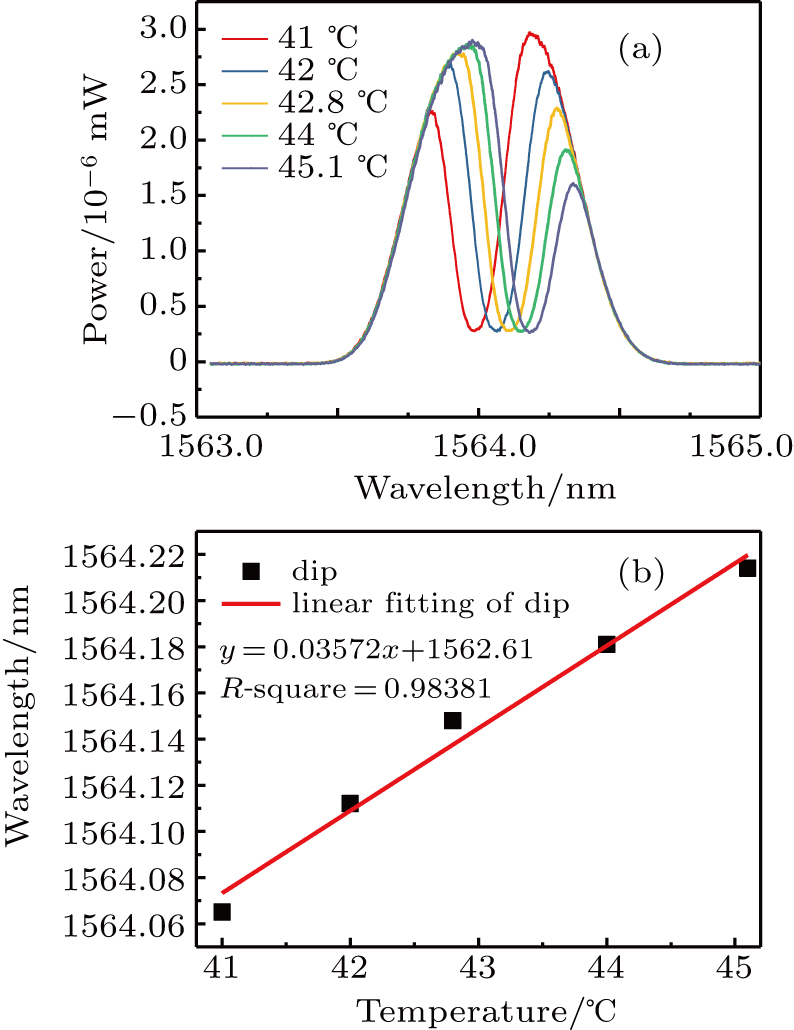 | Fig. 5. (a) The measured spectrum of the temperature sensor. (b) The relationship between the temperature and the interference dips. |
According to the above experiments and analysis, we have confirmed that the proposed system has two different functions that can monitor strain and temperature changes. The main advantage of the proposed system is a simple configuration to extend the measurement channels with a single optical source and a spectrometer. With different sensors, we can obtain different parameters of the environment at the same time. Moreover, the sensors in this system can be placed at different areas through an optical fiber network. Therefore, we can realize the function of a remote monitor using this system. Although the resolution and stability are not sufficient to be at nanometer levels, in fact, the performances of the system can be improved with the development of the optical sources and optical fiber sensors.
We have proposed a novel and efficient multi-functional optical fiber sensor system based on a dense wavelength division multiplexer. The system consists of an optical fiber temperature sensor, an optical fiber strain sensor, and a 48-channel DWDM. This system can monitor temperature and strain changes at the same time. The ranges of these two sensors are from −20 °C to 100 °C and from −1000 

| [1] | |
| [2] | |
| [3] | |
| [4] | |
| [5] | |
| [6] | |
| [7] | |
| [8] | |
| [9] | |
| [10] | |
| [11] | |
| [12] | |
| [13] | |
| [14] | |
| [15] | |
| [16] | |
| [17] | |
| [18] | |
| [19] | |
| [20] |


